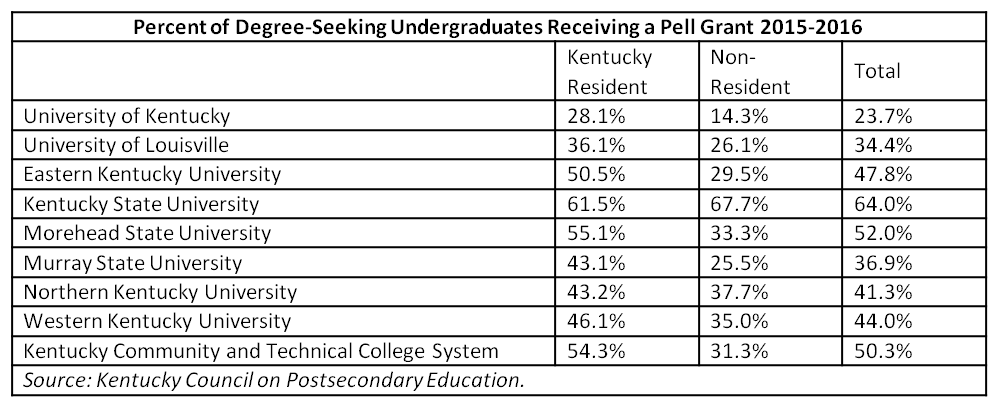The recent U.S. House budget resolution would slash the Pell Grant program by $75 billion over the next decade, cutting the maximum grant by $1,060 or 18 percent. Pell Grants help expand college access and economic opportunity in Kentucky, and cuts to the program would be incredibly harmful.
Pell Increases College Access in Kentucky
Pell provides need-based grants to undergraduate students who haven’t yet earned a bachelor’s degree; unlike loans, students don’t need to repay them. For the 2017-2018 school year the maximum amount for a Pell Grant is $5,920.
Last year 102,360 students in Kentucky received a Pell Grant and the state’s postsecondary institutions received $372,576,000 from Pell. You can see the breakdown by Congressional District here.
The table below shows the share of students at the state’s public universities and community colleges that receive Pell Grants.
Pell Students Are Low-Income, Often Nontraditional Students
As noted in a recent report, “Pell Grants play a critical role in expanding postsecondary opportunity for non-traditional and historically underserved populations, including older students and students who are parents.”
Pell recipients are by definition relatively low-income. More than half of all Pell Grant recipients had family incomes below $20,000; 70 percent were below $30,000. Pell grants are largely based on a student’s Expected Family Contribution, which is determined by a family’s income, assets, size, the number of family members in school, whether the student is a dependent or independent, and whether the student has dependents. The largest awards go to the lowest-income students.
Pell students are also more likely to be older, a member of a racial or ethnic minority group, financially independent and a first generation college student. In addition, nearly 4 in 10 veterans attending college (38 percent) receive Pell.
Pell Works
Research indicates Pell not only broadens access to college, it also helps students be more successful —by reducing drop-out rates and increasing academic success. A $1,000 increase in Pell has been shown to reduce the likelihood of a student withdrawing by 6 to 9 percentage points and to increase lower-income students’ chances of getting a bachelor’s degree within 6 years by 3 percent. Pell is also associated with other measures of success such as transferring to a four-year institution or getting an associate’s degree or certificate.
Pell Grants Are Already Modest
Pell currently covers just 29 percent of the average costs of tuition, fees, room and board at public 4-year colleges — its lowest level in more than 40 years. In 1975, a Pell grant covered 79 percent of these costs. Cuts to Pell in the federal budget would mean further erosion of the grant’s purchasing power, especially given tuition at Kentucky’s public universities and community colleges keeps going up.




